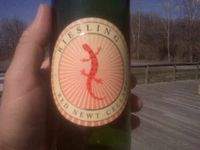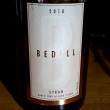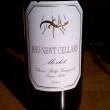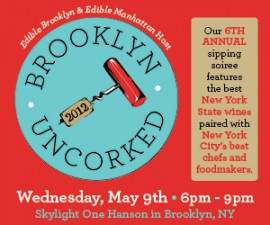The Circle of (New) Life: Red Newt Is Evolving
By Evan Dawson, Finger Lakes Wine Correspondent
Photo Courtesy of Dave Whiting
 Dave Whiting does not simply want Red Newt to survive. He wants it to thrive, and he admits that it's tougher now than ever.
Dave Whiting does not simply want Red Newt to survive. He wants it to thrive, and he admits that it's tougher now than ever.
"Ten, twenty years ago you could open a winery in the Finger Lakes, open the doors, and be viable as long as the wine was decent," Whiting said after bottling a wine that he thinks will make a serious impact in markets outside New York state. "Now, with more wineries opening and production rising, you have to find ways to differentiate yourself. I don't just want to increase production. I want to focus on what I believe we do best, and before anything else, that's riesling."
So here's Red Newt's blueprint:
- Crank up riesling production.
- Offer it at a price point to compete with high-volume producers such as Chateau Ste Michelle and Covey Run.
- Make it better than those high-volume producers.
- Ditch the marginal wines, otherwise known as chardonnay and sauvignon blanc for Red Newt.
If this works, it could become the model for other mid-size Finger Lakes wineries.
Red Newt's riesling production is jumping from 800 cases in 2007 to 2800 cases in 2008, and it should rise to well over 8000 cases within four years. Whiting has contracted plantings with several local growers, and there are now 20 new acres of Riesling in the ground, all of it earmarked for Red Newt.
The winery will still produce a Dry Riesling and the Reserve Riesling will sell for around $22, but most of the Riesling production will be devoted to the new, so-called "Circle Riesling" — the unofficial name is a kind of joke at the winery that comes from the circular label on the bottle.
"We think this wine is a breakout wine that will compete extremely well with wines from other regions," Whiting said about his new wine that clocks in at 3.2% residual sugar. The idea came not long ago, he said, when he was in a local wine store.
"I walked into the Finger Lakes aisle and everything was about $14 or $15. The Finger Lakes tends to offer a lot more in a riesling when it comes to fruit intensity and structure, but the market is price-sensitive. It's time to enter into a pricepoint that is a little bit lower so we can be highly competitive."
Circle Riesling will retail for $11.99. "It's definitely a medium-sweet wine, and that's by design," Whiting explained. "It's similar in sweetness to what you'll find from the high-volume producers, but we think it's much crisper and carries more structure."
NExt is ditching the marginal wines. Whiting enjoys a good sauvignon blanc or chardonnay, but it's clearly not where his passion lies as a winemaker.



















This is definitely interesting and you have to admire Dave and team for seeing an opportunity and going for it.
The thing that I like best here is cutting out the chardonnay and sauv blanc. There are a lot of wineries who try to make too many wines (throughout New York). Yes, diversity is great and enables you to hit more people, but there is something to be said for specialization.
Are there any Finger Lakes producers doing JUST riesling and gewurzt? (or nearly so) Or maybe a different focus? I know that Hearts and Hands do pinot and riesling, right?
This is a tough issue. At Fox Run, we resisted making back-sweetened reds for the longest time, and saw people’s money staying in their wallets until they could find a winery that made one.
Red Newt is exquisitely well positioned to exploit more of the elite demographic. I would love to stop making what we acknowledge to be cash-flow wines — spreading thin here is almost better described as hemorrhaging. And profit margins at the wholesale level for less expensive wines are laughable - a couple dollars per case.
Dave is right on the money (literally and figuratively) with his new Riesling release. After all, he has a virtual monopoly on great ideas. But growing the grapes and making the wine will always be way more expensive here than in WA.
I sympathize with Red Newt’s perspective in terms of dollars and “sense”, although I wonder how a sweeter riesling will be viewed in comparison to the drier wines that David is so capable of making.
If a broader swath of consumers are exposed to sweeter Finger Lakes rieslings, will they be in a position to recognize and appreciate the region for its stellar dry rieslings? Or, is dry riesling always going to appeal to a limited group and a winery might as well make both products and not worry about affecting perception of either one?
In my own experience, I am always a little bit annoyed when people call riesling a “sweet” wine, but maybe there’s nothing that can be done about that.
Jason,
I hope Dave chimes in, but I’ll take a shot. My guess is that Dave would largely agree that the emerging Finger Lakes style of Riesling is electric, cutting, juicy, and clean. In terms of our best efforts and in terms of how critics perceive our style, that’s it. Circle Riesling seems designed to be a touch different, effectively doing two things:
1) Showing consumers that sweeter Rieslings can have more cut and crispness
2) Competing on a quality scale with the big names that dominate that sector of the wine market.
Is there a danger that larger production of sweeter FL Rieslings will skew public perception? Perhaps, but I know Dave and Brandon are confident that these will still be balanced, crisp wines.
I applaud the idea, and wish Dave and Brandon success with it.
As for Riesling styles that sell: I have always felt that one of the most successful American Rieslings, Chateau St Michel’s, bordered on the ‘too sweet’ side, not to mention backbonelessness. But that wine sells like crazy.
Last week, I had the misfortune to come upon a Mendocino County Gewurztraminer and Riesling each with these finished stats hovering at just over .6% and just under .6% total acidity respectively, pH for each near 3.5, sugar between 2.5 and 3% The taste of the Gewurztraminer was nearly insipid. I didn’t get a taste of the Riesling, but cannot imagine that I would have liked it.
The tasting room manager talked about how fast each wine sells.
Many wine critics and writers either fail or refuse to understand that the majority of consumers still prefer wines with noticeable r.s. It’s nice for a winery to service us so-called dry wine consumers, but a winery has to offer what will make the winery profitable, however that equation works out for the winery, its production volume, and its customer base.
Not all critics, Thomas!
It’s not my preferred style, but almost every riesling winemaker I speak to (in the U.S. anyway) talks to me about his/her desire to make a drier riesling (if they only make one as part of a larger portfolio). But the fact is, the sweeter style sells… and sells VERY well.
Obviously I have yet to taste this new Red Newt riesling (Evan, did you try it?) but if this is a sweeter style but with better backbone, it’s certainly worth checking out.
The thing that will be interesting though is how the increased acidity change the perception of that sugar. Will crackling acidity cut through the RS to the point that the masses won’t find it sweet enough? It’s a tightrope to walk.
Looking forward to tasting it. And let’s not forget the other big news — cutting chardonnay and sauv blanc. I can think of a couple dozens wineries who would probably do well cutting a few varieties.
Lenn,
I never tasted it from tank, and it’s being released tomorrow, I believe. So not yet. They’re fortunate in that, by all accounts, 2008 was a stunningly balanced Riesling year. I wonder what a 2007 Circle Riesling would have been like with 3.2%.
I hope Dave Whiting will jump in here and explain a little more on his idea for the wine.
And yes, there I go again posting from my wife’s computer. This is Evan.
Jump, Dave, jump.
Oh, and I am one of those guys who believes that most wineries produce too many different wines. I understand why they do it, but I have to think that the more variety offered the less chance for allowing your winery to develop a focus, or allowing the consumer to develop a focus.
I suppose it’s particularly New World-ish to believe that every location can produce every kind of varietal wine. I often wonder how that philosophy fits with the idea of ‘terroir.’ But let us not get on that subject!
I applaud Red Newt’s Riesling attempt and its dropping of a few varietal wines form the line up.
Those of us immersed in Riesling on a daily basis get excessively caught up in the sweetness issue. New York Rieslings have exceptional acidity, so they can have a high sugar level but not a high perception of sweetness.
Case in point: 2 years ago, I served as a tour guide to California-based wine writer Leslie Sbrocco (Wine for Women) during her visit to the Finger Lakes. She found all the Rieslings she sampled-those labelled dry, semi-dry, and semi-sweet- to be “dry” in her lexicon. She found it fascinating that we made such distinctions at all.
Shannon, are hung up on the ‘dry’ vs. ‘sweet’ thing. They fully believe that use of the word ‘dry’ to denote a Riesling with high acidity yet with noticeable RS is cheating or lying.
are hung up on the ‘dry’ vs. ‘sweet’ thing. They fully believe that use of the word ‘dry’ to denote a Riesling with high acidity yet with noticeable RS is cheating or lying.
Many wine geeks, the ones with all the money
In my view, use of the words ‘dry’ and ‘sweet’ for any wine are problematic, as their use is focused in the wrong place.
People use the words to describe the wine, but in actuality, the words describe how the palate perceives the wine. The only way to get people to understand the thin line that separates the wine from the palate is to change the way the two words are applied as descriptors or drop them completely and come up with a better way to approach the subject.
Originally, the word ‘dry’ was applied in France as a way to describe the sensation on the tongue that Bordeaux reds left behind-dried out the tongue-but that meaning has been subverted.
Great posts, everyone - we really appreciate your input on this Riesling. Dave will chime in shortly, so I will only add one tidbit with regard to the sweet vs. dry dialogue. This “Circle” Riesling is the first bottling out of Red Newt to include the new International Riesling Federation scale on the label. Historically, labels with semi-dry, off-dry, or even dry have always been completely subjective, and often confusing to the consumer. The new scale uses a crafty integration of pH, acid, and sugar to assign a sweetness designation. Essentially it does what our senses do, and equates perceptible sweetness against the acid backdrop. It’s a massive step in the right direction.
Ah well, I maintain that, with regard to the palate, the opposite of ‘dry’ is not ‘sweet.’ That’s mainly because of the vagaries of perception. No scale or otherwise method will train people away from their perception.
The best course is to change the dialog instead of to focus more intensely on it.
But I also know that I may be a minority of one on this, and that, perhaps, is the story of my life
I’m pleased that my 2008 “Circle” Riesling has generated a bit of conversation. I have to agree with most of the comments above. There are a couple of things that I’d like to take a few words to touch upon. The idea of “sweet” in the context of Riesling is a difficult one. Brandon pointed out that we have adopted the IRF Riesling scale for this Riesling. It falls in the “medium sweet” category. The balance of our 2007 “Semi dry” Riesling is just a bit sweeter (a little less sugar AND a little less acid), and most of our previous vintages, which we referred to as “off-dry” are a bit drier in balance.
Producing a wine that is market savvy and approachable in style and price does not necessarily devalue the other wines in my portfolio. I feel that the quality of the wine is there, and by best argument to anyone is to suggest tasting and forming one’s own opinion. I think that there is a risk (perhaps one that is showing itself now in some peoples minds) that when one suggests that a wine is a bit sweeter, approachable, and competitively priced, that people may imagine that the wine is in some way substandard.
When I produced the first vintage at Red Newt in 1998, one of the six (6) wines that made up the portfolio was a semi-dry blend of Vidal and Cayuga named “Red Newt White”. My goal in creating this blend was to create a wine that had a bit of sweetness that would appeal to the masses while, at the same time, had a crisp backbone of acidity to make the wine approachable for a more seasoned dry wine set. The wine was and is very successful. But in the context of sales outside of a regional market, it shows limitations due to its varietal composition. The Riesling that is the topic of this blog shows a similar chameleon like personality that blends into the palate of both the sweet and dry wine drinker. That’s the goal.
So, if Finger Lakes Riesling is so good, why are we not selling every drop we can think of making? Well, for a number of years we were, primary to a regional upstate market. But as acreage increases in the Finger Lakes at a rather steep rate, and other regions jump on the Riesling bandwagon (you’ve seen them from Australia, Chile, Spain…) we producers in the Finger Lakes need to take a proactive stance in marketing our wine both here and in areas outside New York
.
Evan mentioned some large brands which dominate the North American Riesling market. If we can make a wine as good or better (we can) and sell it for a price that is in the same ballpark, we should have a potential of taking some portion of that market in spite of our minuscule (by comparison) marketing budget. But, with production levels with those brands in the million case range, a small slice of pie will work effectively for our current market needs.
So that’s the idea. Produce a wine that’s really good and appealing in both taste and price. Introduce new consumers to my brand and , by association, to Finger Lakes Riesling. Present that product as an ambassador to create awareness of the full breadth of my brand. Grow Red Newt and the Finger Lakes together. Let’s see how it goes.
Thanks for your insight, Dave. You make an important point: You’re aiming to create a wine that will compete and succeed against the biggest names, but case production will never even sniff what the CSMs of the world can make. Therefore, you don’t need to carve out too much of their market share to make such a venture entirely worthwhile.
I hope that, going forward, you’ll keep us updated on your efforts to break into new markets. There seems to be a growing opinion in the FL that wineries can not survive on tasting room sales alone (this is, obviously, rather dependent on the size of the operation). Breaking into new markets is an important next step.
Hear, hear.